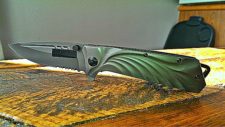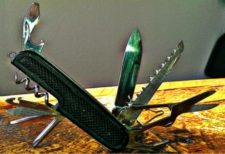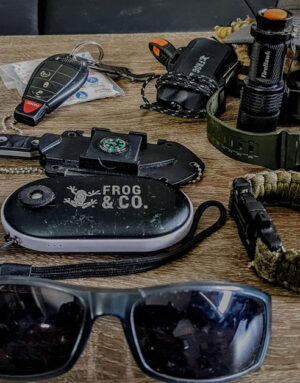
A Guide About Everyday Carry Best Practices, Truths & Mistakes
Because those of us who understand what E.D.C. means are kindred spirits.
We know the fragile masses will never fully understand us (at least not until it’s too late).
We’ve spent (and will continue to spend) countless hours assembling the Best Everyday Carry setup, all in the name of:
- Being prepared
- Adapting
- And Overcoming
I cannot fathom going anywhere without my EDC.
Call me paranoid…fine; call me weird…OK, but call me ready.
TOPICS IN THIS GUIDE… ↓(click to jump)
- Why EDC In Two Words
- What’s ‘The Best’ EDC Setup?
- 6 Universal Truths For EDC
- 6 Best Practices For EDC
- Important Questions to Ask
- Common ECD Mistakes…
Note: You should watch my EDC carry setup in the video below…
↓ EDC List – My Everyday Carry Setup
Why You Should EDC In Just 2 Words
2 simple words sum up and express my passionate feelings about this topic.
These 2 simple words dissolve all unprepared folk’s silly rebuttals.
Do you have any guesses about what these 2 words are?
These 2 words are not sexy.
They won’t win any academic awards.
When put together, many consider them crude and in bad taste, but…they are powerful and profound.
This statement of inevitable fact is why I don’t leave the house without my trusty EDC…ever.
Sh*t Happens and turns even the best-laid plans to waste.
- No one plans to get lost on a hike.
- No one wants to get stuck in a blizzard on a remote hunting excursion.
- No one prefers to get in a rollover car accident on a rural highway (stupid deer came out of nowhere!)
- No one expects to get mugged by a roaming band of kids downtown in any major city.
We all know Shit Happens to everyone every day, but we don’t know when Shit will Happen to us…that is why we EDC.
Every day carry (EDC) refers to a small collection of tools, equipment, and supplies that are carried daily to assist in tackling situations ranging from the mundane to the disastrous.
That’s the technical definition of EDC; however, it’s more than this to me.
EDC is a discipline, a philosophy, and a way of life.
A life of absolute preparedness.
So What Is The Best EDC Setup?
As with most topics worthy of ongoing conversations, there is no “absolute best” everyday carry setup.
There are only degrees of good and bad, which depend greatly on your tastes and circumstances. Such as:
- Where do you live? What’s the regional climate? What season is it?
- What skills do you currently have? What type of population area will you be in?
- What clothes do you tend to wear?
- What are the local laws?
However, with that said, there are a few universal truths and best practices when assembling your own personal perfect EDC.
So let’s jump right in…shall we?
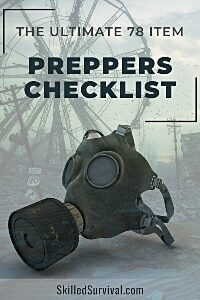
Want a free 78 item preppers checklist?
Enter your email below to instantly download this Complete Checklist PDF. No purchase necessary. 👇 👇6 Universal Truths For Your Everyday Carry Setup
1. The M0re Portable The Better
This one doesn’t require much explanation, but it’s an excellent truth to remember before purchasing items to add to your EDC.
Heavy or bulky items tend to be annoying to carry.
So these items end up on the sideline after a while.
2. Multi-tools Are The Best
Or the “Swiss Army knife truth.”
Tools that can be used for several survival functions help consolidate space.
A couple of examples of these tools include: Swiss Army Knives / Paracord / Watch and Compass Combos
3. Pockets Are The Tip Of The Iceberg
Pockets are the first place to carry items, but you should also consider waistbands, leg bands, fanny packs (who cares if these are not “fashionable”), and cargo pockets.
A pair of cargo shorts or pants can carry some good EDC gear.
4. If It’s Not Convenient To Carry, You Won’t
Similar to Truth 1, if it’s a pain to carry, it will migrate from your EDC to your extended EDC (which can be OK).
If it’s a huge PIA, it may migrate from your extended EDC to your garage.
Not even the most amazing survival tool will help you when left behind in your garage.
5. Knives & Guns Can’t Go Everywhere
Due to these silly restrictions, I drive whenever I can for most of my travels.
So I rarely take my knives or guns out of my EDC, but I reluctantly leave my knife and gun behind when I fly.
However, I typically add my self-defense survival pen to my EDC because I want to have some basic form of protection no matter what.
6. Your Best Everyday Carry is NOT your Bug Out Bag
Some new survival preppers get these 2 items confused.
Your EDC is a few basic tools and items you can carry with you at all times to give you an edge when Shit Happens.
Your Bug Out Bag is for getting out of dodge with many more essential survival items.
6 Best Practices For The Best Everyday Carry Setup
1. Create A Basic Carry & An Extended Carry
You should have a minimalist setup and an extended “special” circumstances carry setup.
Then you can always grab your everyday carry gear no matter what.
However, you can also take your extended carry gear whenever feasible.
2. Collect Smaller Items Into A Portable Container
My favorite small tin container is an Altoids container.
They are a perfect size (small), shape, lightweight, and well-secured when closed.
3. Wear Clothes With Lots Of Extra Pockets
Cargo shorts, cargo pants, jackets with internal pockets, etc.
 4. Small Tactical Backpacks Are Excellent For Your Extended EDC Bag
4. Small Tactical Backpacks Are Excellent For Your Extended EDC Bag
The extended carry is typically a small backpack, so take it with you whenever you go somewhere where backpacks are ok.
Even if you go somewhere where backpacks are not allowed, you could still leave them in your vehicle.
Then all you’d need to do is get back to your vehicle to have your extended tools in a survival scenario.
5. Pretend Your Smartphone Is Useless
You’re stupid if your survival plan depends on your cell phone or smartphone signal, GPS, or apps without backups.
Sorry, I was trying to think of a nicer adjective here, but “stupid” seems right.
Smartphones need the power to function; in a Shit Happened survival scenario, it will be rare to have any power available.
I don’t care what apps you have; they will be useless to a dead smartphone.
A dead “smart” phone might as well be called a “dumb” phone.
6. Prioritize Your Build Based On 3 Distinct Criteria
- Criticality
- Frequency of Use
- Size / Weight of Object
When you are trying to build your EDC or modify your EDC, there are 3 distinct characteristics of each potential tool.
- Its usefulness to a survival scenario or its Criticality.
- How often will you use the tool or its Frequency of Use?
- Its overall Size and Weight.
If you then take each of these categories, give them a couple of subcategories, and represent them with some numbers, you can create a nice priority chart.
For example, you can use the following numbering system:
- Highly Critical = 1
- Low Criticality = 2
- High Use = 1
- Low Use = 2
- Light / Small = 1
- Heavy / Bulky =2
A simple numbering system like this can help narrow your EDC tool items to include or exclude.
Choose a sub category for each potential EDC tool and multiply these 3 numbers to get a priority number.
Critical tools used often, and are small, will have lower numbers than tools that are just nice to have, rarely used, and heavy.
In general, the better everyday carry tools should have lower numbers, and the less friendly EDC tools would get higher numbers.
This can be an excellent exercise to ensure you do it right when building your EDC.
Let’s do an example:
Let’s take a large Survival Knife such as this one.
Critically, I’d have to give a survival knife like this one a 1.
I’d give it a 2 on the Frequency of Use, but for the Size and Weight, I’d call this knife a 2 (it has some heft).
So 1 * 2 * 2 = 4
Let’s do another example:
Let’s take a small multi-functional survival tool.
Critically I’d again assign it the number 1.
I’d up the frequency here since this tool has many more uses 1.
I’d call this small and light as well, so another 1.
So 1 * 1 * 1 = 1
The smaller multi-functional army knife is probably the better EDC tool.
Mostly become of its functionality and compact size.
Note: This does not mean the heavier survival knife is useless.
It’s the main knife I keep in my pickup truck, and I always add it to my extended carry setup.
However, it’s just too bulky and heavy for my E.D.C.
This type of analysis is not an exact science, and everyone will choose different numbers for their subcategories.
Still, it’s just a simple way to think deeper into your personal everyday carry build.
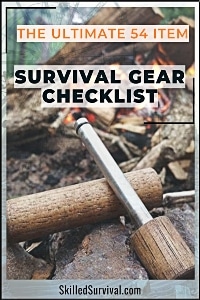
Want a free 54 item survival gear checklist?
Enter your email below to instantly download this Complete Checklist PDF. No purchase necessary. 👇 👇A Few More Great Questions to Ask
Is this tool useful to the region in which I live?
Having a compass on your survival knife is silly if you rarely live in rural areas.
If you live, work, and play in an urban environment, save the weight for something else.
How many functions does this tool have?
Carrying a knife, scissors, and saw all as separate tools is highly impractical.
However, if you can find a tool that bundles these items into one multi-tool, that may be a much better option.
Is the tool usable?
Make certain your new tool has a generous return policy.
You’ll want to thoroughly test any gear before fully committing it to your everyday carry.
What happens if you don’t test your new wonderful survival tool and then it breaks the first time you do need it?
Not cool.
Cost?
As with most things in life, you get what you pay for.
Do basic research, and don’t get sucked into the marketing spiel.
I’d rather you build your EDC over time and get good-quality gear than have a complete EDC with many suspect tools.
Is there anything lighter or more compact?
Bigger is not better when it comes to your EDC.
If a comparable tool is a few ounces lighter, choose the lighter option; you’re back and can thank me later.
Will this tool give me a greater chance to survive?
Some tools can do some pretty incredible stuff.
While it’s very cool that a tool can help you eat with proper manners (fork and spoon), is it going to keep you alive in a desperate situation?
If yes, that’s a worthwhile EDC tool; if not, pass.
The Most Common Everyday Carry Build Mistakes
1. Carrying Too Much and Too Heavy
Noticing the theme here?
You’re probably sick of hearing this, but it’s fundamental to your EDC build.
A good EDC build must be light and compact, or you won’t carry it around.
2. Buying Crappy, Cheap Gear
Again, I’d rather you buy quality gear and take a few more months to complete the build.
Better than having sub-par equipment that doesn’t work or breaks when putting it to the ultimate test.
3. Relying Soley On Battery Operated Devices
This includes cell phones, GPS, and flashlights.
You can have these items, just don’t rely solely on them.
Have other means of doing the same thing. Maybe an emergency whistle, compass, and a small hand-crank flashlight.
That said, here’s the main tactical flashlight I use for my everyday carry.
Want a free FireHawk Tactical Flashlight?
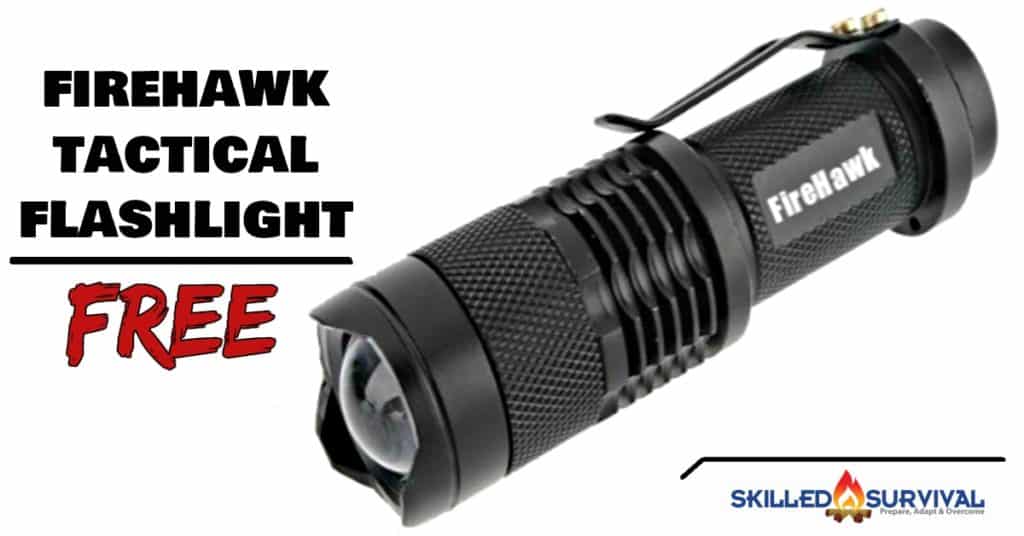 Click here now to access this limited time offer, just cover the small shipping & handling fee.
Click here now to access this limited time offer, just cover the small shipping & handling fee.
↓ Get A FREE FireHawk Tactical Flashlight (+S&H)
4. Allowing Your Gear To Deteriorate
Some items may be ‘set and forget but not your gun or multi-tools.
Your gun must be cleaned and maintained regularly, and your multi-tool should also be cleaned and oiled.
5. Not Fully Testing or Know How To Use Your Gear
Not knowing how to use your survival gear should be a sin.
I realize those are harsh words and might strike a chord with some.
Still, nothing seems more immature and silly than buying nice gear and carrying it around (pretending you’re the smartest person alive) only to fail miserably when using it.
Final Thoughts
It’s not about how much “stuff” you have; it’s all about the skills you’ve acquired.
Those of us who are serious about our EDC builds, tend also to be serious about survival skills.
This is what separates us from the unprepared fragile masses.
We carry this stuff around to give us an even bigger edge to survive if and when needed, but to be honest….
Those of us who know our shit, already have a massive advantage.
Even if we carried nothing extra (but why would we?), we would still know what to do when the time came.
- We could use car parts if our vehicle were nearby to do any number of survival tactics.
- We could turn a bunch of debris into a shelter without any rope
- We could start a fire without matches or a lighter
The list goes on and on……
But again…even though we could do these things without our EDCs, why would we.
EDC every day, my friends; it’s OUR way of life.

Prepare, Adapt & Overcome,
P.s. - I just found out 2 out of 3 Americans don’t feel prepared for a 3 day disaster!!!
I guess this goes to show how modern society continues to embrace ‘living a fragile life.’ What’s crazy is… it’s so easy to fix.
To make sure YOU have the basics, watch our FREE training on “10 Simple Steps To Basic Preparedness” that shows you HOW.
Nothing crazy here… this isn’t doomsday prepping... just the basics every responsible adult should have before a disaster strikes.Why You Can Trust Skilled Survival...
Go here now to review a full breakdown of:
- Who We Are
- Our Credentials
- Our Mission
- & Product Recommendations...
Here are a few highlights of our teams credentials & certifications:
- Certified Member of a Mountain Search & Rescue Organization
- Plant Emergency & Safety Leader for a Major Food Manufacturer
- Member of the 10TH Mountain Division Hut Association
- Certifications: Avalanche 1, WFR, CPR
- Official Gear Tester for Numerous Outdoor Gear Companies
- Countless Multiday Backpacking trips into Remote Wilderness
- Bachelor's Degree In Mechanical Engineering
- Bachelor's Degree In Civil Engineering
- Bachelor's Degree In Biomedical Engineering
"It takes 20 years to build a reputation and five minutes to ruin it." - Warren Buffett
We're fully aware that trust is NOT something you GET but is EARNED.
And we'll continue to earn YOUR trust through our forthright and honest approach with each new Blog Post, Guide & Product we create...
P.s - I just took this FREE 60-second 'Readiness Score Quiz'👇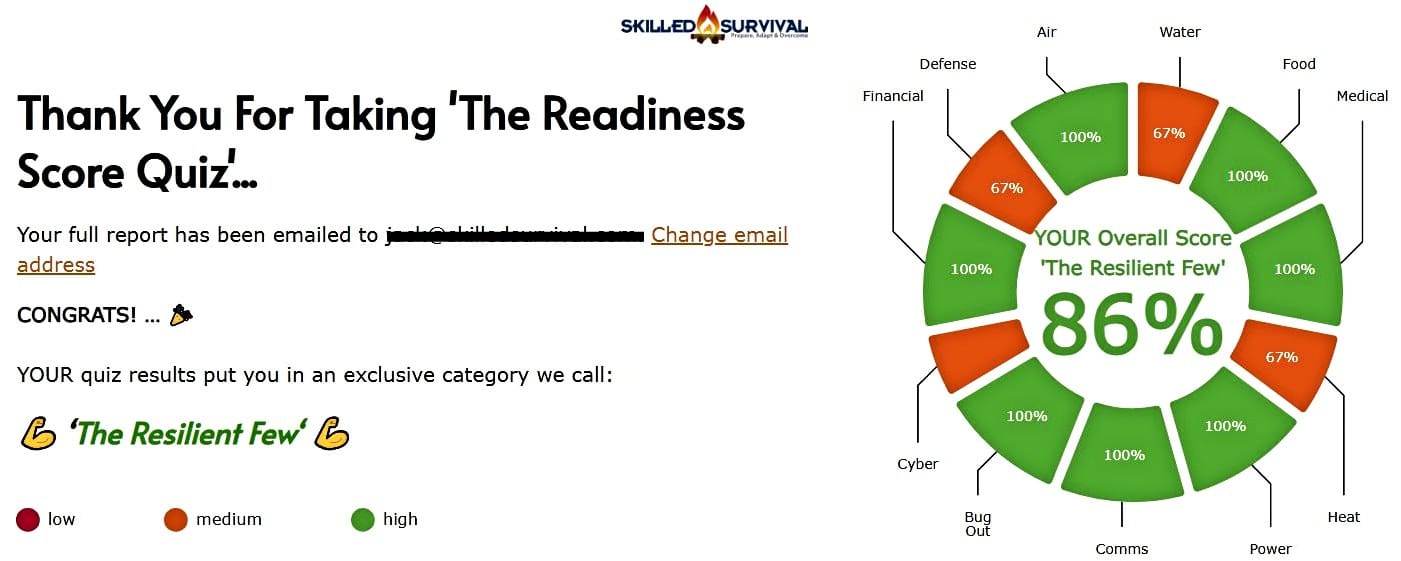
AND... I've still got a few gaps in my preps...🤔 But at least, I'm not part of 'The Fragile Masses'. 👍 Find out where YOU stand by answering a few questions...
Top Photo Credit: 1
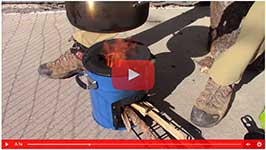
Recommended Reading
Long Term Fuel Storage For Survival Emergencies
Long term fuel storage is crucial in emergencies, but fuels must be stored properly especially long term gasoline storage.
How To Store Seeds For Wise Prepping & Survival
When seed saving and seed storage, you must do it right. Learn how to store seeds so they'll thrive the next planting season.
Strategic Relocation: How To Find A Safe Pace To Live
Use strategic relocation to find a safe, defendable location to call home. Your choice of location WILL determine your survival fate.
Nuclear Fallout Map: Would I Survive A Nuclear Bomb?
Have you seen this nuclear fallout map? Or run a nuclear simulation to see the damage a nuke would do to your city? If not, check this out.
Homestead Survival: How To Master Plan Your Safe Haven
Use this simple 6 homestead survival plan to successfully survive (and thrive) even if the world falls into chaos...
Nuclear Attack Scenario: Horrific Facts You Must Know
Welcome to our modern nuclear attack scenario. As tensions rise the FEAR of a nuclear exchange is fading and complacency kills.



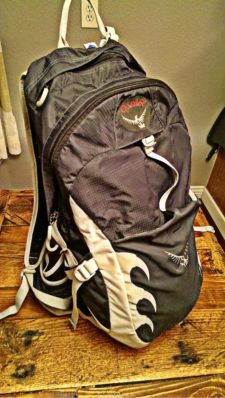 4.
4. 